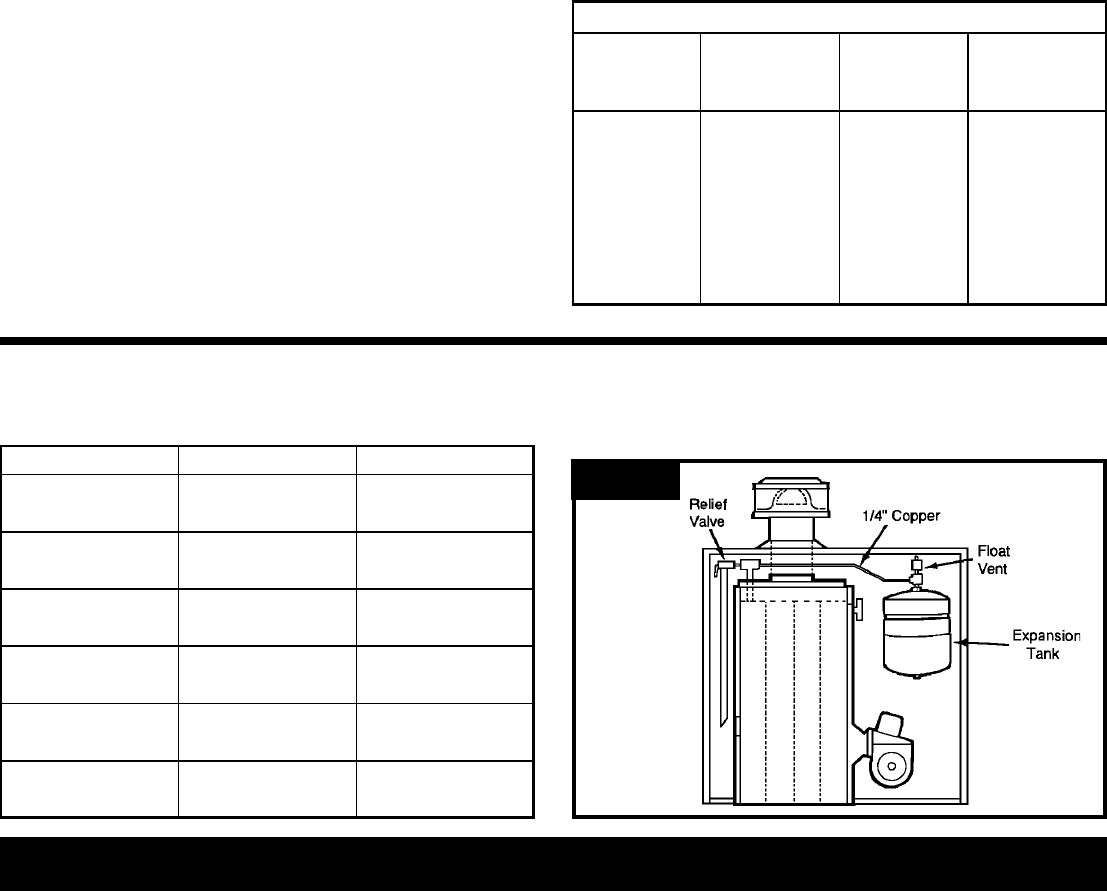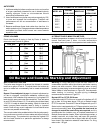
ANTIFREEZE
1. Antifreeze added to boilers must be non-toxic, and must be
of a type. specifically intended for use in closed hydronic
heating systems. Under no circumstances should
automotive antifreeze be used.
2. Use of antifreeze in any boiler may reduce capacity by 10%
or more and increase fuel consumption. Tankless coil
performance will fall as concentration of antifreeze is
increased.
3. Because antifreeze forms slush rather than hard ice, it is
safe to protect only to 10 degrees above coldest temperature
anticipated provided slush formed can move towards
expansion tank.
26
MODEL NO.
VOLUME
IN GALLONS
MODEL NO.
VOLUME
IN GALLONS
DPF3 7 DPF3T 10
DPF4 9 DPF4T 12
DPF5 11 DPF5T 14
DPF7 15 DPF6T 16
DPF9 19 DPF8T 20
DPF7TT 21
WATER VOLUMES OF PF SERIES BOILERS
PIPE SIZE PIPE MATERIAL FACTOR
½" Copper 82.5
½" Steel 63.5
¾" Copper 40.0
¾" Steel 36.0
1" Copper 23.3
1" Steel 22.2
1¼" Copper 15.3
1¼" Steel 12.8
1½" Copper 10.8
1½"Steel9.5
2" Copper 6.2
2" Steel 5.8
PIPING VOLUMES
Divide total length of piping in feet by Factor A below to
determine water volume in gallons.
ALTERNATE AIR ELIMINATION METHOD
As boiler temperature increases, air will move from top of boiler
toward float vent even if lower. As boiler temperature
decreases, water will move from expansion tank toward boiler.
FIG. 23
Oil Burner and Controls Start-Up and Adjustment
WEATHERPROOF BOILERS
This boiler was designed to produce the ultimate in useable
heat from a gallon of fuel oil. To adjust the air-fuel mixture by
eye is to waste fuel unnecessarily and to create undesirable
soot.
Repeat - Do not adjust air by eye. Any time air adjustment or
oil rate is changed, combustion must be checked with
instruments. With chamber fully warmed up, find highest C02
level at which zero smoke can be maintained. Then add extra
air until C02 falls off about 1%. Final setting should be at least
11% C02. If unable to obtain that reading, check for internal oil
leaks, incorrect flame retention head or faulty or incorrect
nozzle. Draft will vary as air is adjusted. It should be left at as
near zero as possible at breeching.
The correct nozzle is the smallest which will do the job properly.
Long continuous runs with minimum starts and stops conserve
the most energy. The nozzle which provides the highest C02
with the least smoke for a particular application is always
recommended.
Warning: A firing rate that is too low can result in a
condensation problem within the chimney and boiler causing
severe rust and corrosion. When domestic water is being
heated, by-pass piping is recommended only when an Indirect
Water Heater is used as shown on Figure 20. If no domestic
water heating is involved, by-pass piping is always
recommended as shown on Figure 21.
Beckett AFG or CF375 Oil Burner
A Beckett model AFG oil burner is used to fire boilers at 2.00
gph or less. At firing rates above 2.00 gph, a Beckett model
CF375 is required. A model AFG burner shipped with your EV
Series boiler is equipped with an F3 flame retention head, the
size most commonly used. It is possible the head must be
changed to match the nozzle firing rate required, and it is
recommended the installer carry a complete assortment of
Beckett flame retention heads. When head ratings overlap, a
smaller head with air shutter fairly well open will generally
provide better combustion than a larger head with air shutter
near closed. See head size selection chart below. For firing
rates under 1.00 gph


















